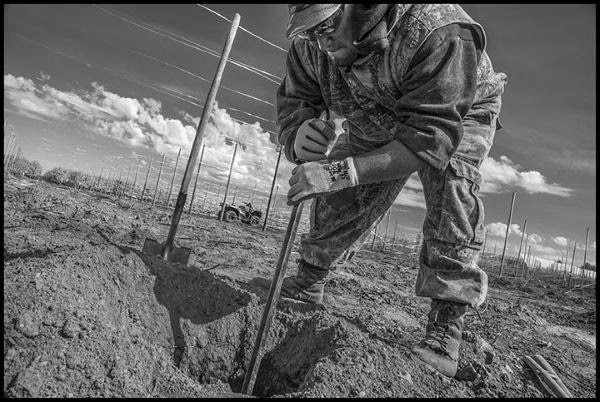On October 2 Trump finally dropped the hammer on farmworkers. At the end of the season, when most workers who might protest are no longer in the fields, he cut the wages of 400,000 people by as much as a third.
Trump’s order, a Federal regulation published in Thursday’s Federal Register and implemented immediately, alters the way wages are set for farmworkers brought to the U.S. by growers on H-2A visas. These workers are recruited mostly in Mexico, and sign contracts to work for a maximum of 10 months per year. After that, they have to return home.
H-2A workers are very vulnerable to pressure from their employers. They can only work for the growers who recruit them, who can legally impose production quotas and fire workers for not meeting them. Recruiters are legally allowed to refuse to hire women, and almost all H-2A workers are young men. They can be fired for protesting, organizing, or simply working too slowly. They then lose their visas and usually find themselves on a blacklist, unable to return to work in subsequent seasons.
Existing Federal regulations require growers to provide housing, and transportation from the border and to work every day. Every year the Department of Labor sets a minimum wage for each state, called the Adverse Effect Wage Rate. It is usually a little higher than the state minimum wage in those states that have them. The reg’s original intent was to keep H-2A wages high enough that growers wouldn’t use H-2A recruits to displace local farmworkers. The new regulation changes both the wage system, and the housing requirement.
The new rule, called the “Adverse Effect Wage Rate Methodology for the Temporary Employment of H-2A Nonimmigrants in Non-Range Occupations in the United States,” says the wage in California for Skill Level One farmworkers will be $16.45 per hour. That’s a nickel below the state’s minimum wage this year. There is a higher, Skill Level Two wage, of $18.71, but Daniel Acosta, immigration director for the Economic Policy Institute, believes that “more than 90% of H-2A workers will get the lower wage.”
Today the existing AEWR wage, received by the 37,511 H-2A workers who labored this year in California fields, was $19.94. The wage those workers will be paid when they return next year, if growers pay the state minimum wage, will be $16.90 per hour, or three dollars less than they were paid this year. In addition, the new regulation allows growers to charge H-2A workers for housing, which they previously had to provide for free. In California, the allowed charge will be $3.00 per hour. The total cut will therefore be from $19.94 to $13.90 – over six dollars.
The day after the regulation was issued I stopped to talk with two H-2A workers at an old motel in California’s wine country. A half-dozen farm labor busses, all with Mc4F Solutions, LLC, painted on the side, were parked in front. The company is listed is an H-2A labor contractor, according to the Centro de los Derechos del Migrante, an advocacy organization for H-2A workers. The two said they’d been coming to work in the same vineyards for several years, and joked that by now they knew each vine personally. Both depend on the work to support families back home. Being away for most of the year, for them, was the biggest downside.
When they return next year, however, the company will have to tell them about the new, lower wage. In addition, they’ll be paying about $500 a month to sleep three to a room at the motel. The company may even save enough to buy the place. All over California H-2A labor contractors have taken over old motels, a process this regulation will accelerate. Other growers are building labor camps, now using this involuntary gift from their workers to pay off construction costs.

PORTERVILLE, CA – H-2A workers, working for Porterville Citrus, were housed by the labor contractor Fresh Harvest at the Palm Tree Inn in Porterville. During the pandemic some rooms had notices on the windows saying they’d been decontaminated and/or disinfected. Workers organized a protest when they weren’t paid their full wages at the end of their work contract.
Savings by Napa’s gentlemen farmers and wineries listed on the stock exchange is unlikely to produce good accommodations, however. Bad housing is one of the most common complaints among farmworkers. Nevertheless, regardless of its condition, workers will pay $3.00 an hour for it. The California Department of Housing and Community Development responsible for all employer-provided housing in the state, won’t be much help. It only has three inspectors, and in 2022 it failed to issue a single citation for illegal conditions, while issuing permits without making inspections.
The text of the regulation acknowledges “negative impacts” in government-speak. “Certain current H-2A workers may experience reductions in wages as a result of lower prevailing wage rates,” it warns. According to Marcos Lopez, a researcher for the University of California Davis Labor and Community Center, the total number of H-2A workers who worked in the U.S. this past year is close to 400,000. In simple language, they will get a wage cut. “This effect will be mitigated by an increase in the number of certified H-2A job opportunities, which will create additional employment for new H-2A workers.” In other words, new workers will be recruited if the old ones don’t like it.
Wage cuts for H-2A workers will affect all workers – bitter news for the people who were called essential during the pandemic. But the wages of farmworkers have never corresponded to the difficulty of the job, the skill needed to perform it, or the cost to workers’ families or their own bodies. Last year Juana, a strawberry picker in Santa Maria, told me, “Not many people can do this job,” she said. She’d been working in the berry fields for 15 years. “I have permanent pain in my lower back, and when it rains it gets very intense. Still, I get up every morning at 4, make lunch for my family, and go to work. It’s a sacrifice, but it’s the only job I can get.”
Juana was making $16, then the state minimum wage. The work season lasts for eight months, and produces an income of $21,760. But she and her husband pay $2000 a month rent, or $24,000 a year – more than her entire earnings. “We have to save to pay the rent during the winter when there’s no work,” she added. “If we don’t, we don’t have a place to live. And during those months there are always bills we can’t pay, so by March there’s no money at all, and we have to get loans to survive. Plus, I have to send money to my mama and papa in Mexico. There are many people depending on me.”
This year another worker, Emma, described to me the toll farm work takes on her. “In the oranges I have to climb ladders with a 40 or 50 pound bag on my shoulders,” she explained. “When I’m bunching carrots, I’m on my knees all day. Every season my body has to learn to adjust to the way my hands and back hurt. It can take an hour and a half to get to the field, and for all that the most I make is $700 a week. And last year 70 percent of the time I only got four hours of work a day because the company hired so many other people.”
Emma’s description of the cut in her hours is increasingly common. “A lot of workers come to us, saying they’ve been replaced in middle of season, or that they don’t get the hours they did before,” Sarait Martinez, director of the Binational Center for Oaxacan Community Development, told me. Martinez organizes Indigenous Mexican farm workers in California – people from towns in southern Mexico, speaking languages centuries old when Spanish colonizers arrived.
She explained that recruiters in Mexico target those communities. As a result, Indigenous farmworkers in California, both local and H-2A workers, sometimes find themselves at odds over displacement. “We do a lot of education,” she says, “where we emphasize to workers that the system exploits both. It wants us to fight each other over who has the right to work in the fields.”
To Martinez and other farmworker advocates, the new regulation was not a surprise. “Trump 1.0 used the exact same playbook in 2020,” Daniel Costa recalls. “First he got rid of the Farm Worker Survey used to set the Average Effect Wage Rate, just as he just did again. Then he said he’d just freeze H-2A wages for two years.” The United Farm Workers filed suit and blocked the move.
Discarding the Farm Worker Survey again this past August came after other moves to please growers. At the end of June Trump scrapped the Farmworker Protection Rule, regulations put in place by Julie Su, Biden’s Secretary of Labor, that provided minimal protections for H-2A workers. By getting rid of it, growers can now bar outsiders (community groups or unions) from H-2A housing, give workers contracts in languages they can’t read, retaliate against those who complain of bad conditions, and even stop using seat belts in the vehicles transporting them to the fields.
Trump’s new Agriculture Secretary, Brooke Rollins, promised changes like these in her Congressional nomination hearing. She told Congress she’d modernize the H-2A program “to do everything we can to make sure that none of these farms or dairy producers are put out of business [by immigration enforcement].”
Last year the Department of Labor gave growers 384,000 certifications for H-2A visas, for workers who now make up about a fifth of the U.S. agricultural workforce. That’s up from 98,813 in 2012, and from 48,000 twenty years ago. “Already H-2A workers make up a quarter of the crop workforce,” Costa charges. “Now growers will have a massive incentive to replace more people. We could see 500,000 H-2A workers.”
The new regulation, however, claims the wage cut is needed because of an emergency caused by the administration’s own actions. “With the historic near total cessation of illegal border crossings-the Department must take immediate action to provide agricultural employers with a viable workforce alternative while concurrently averting imminent economic harm.” It parrots grower claims that they face a severe labor shortage because “domestic applicants are not applying for agricultural positions in sufficient numbers.”
Edgar Franks, political director of Familias Unidas por la Justicia, a farmworker union in Washington State, recalls that during Trump’s first administration, Washington State’s Employment Security Department and the US Department of Labor agreed to completely remove the guaranteed piece-rate wage for H-2A workers picking apples, the state’s largest harvest. That effectively lowered their wages by a third, and undermined local workers too. “If wages drop even more, it won’t be worth it to pick apples,” he warned. “They manufacture a labor shortage to deincentivize the work for local workers. If they want to attract workers, they should pay higher wages. But the real intent is to lower wages.”
In addition, Martinez says, “the deportations and kidnapping of immigrants are now an excuse for growers to bring more H-2A workers and cut our wages.” The regulation acknowledges “that illegal aliens currently employed in agriculture may be adversely affected as growers shift toward reliance on the lawful H-2A program rather than illegal aliens.” Martinez counters that “the lack of immigration status disproportionally affects Indigenous workers. But while we’re forced to leave jobs and homes by raids and deportations, growers are still guaranteed workers.”
The new regulation, and the politics behind it, make winning and enforcing workplace rights and decent wages for farmworkers more difficult. Enforcement of even the regulation’s weak worker protections is already in trouble. In 2019, under Trump, only 26 of the 11,472 employers using the H-2A program were punished for labor violations. With Biden the DoL staff fell to only 810 investigators for the nation’s 164.3 million workers, or one inspector per 202,824 workers. Then over 2,700 DoL employees, or 20 percent of its workforce, left the department in the wake of Trump executive orders and job cutting by Elon Musk’s Department of Government Efficiency.
For organizers like Franks, organizing farmworkers is still the answer, especially with a Federal government undermining wages and terrorizing workers with immigration raids. “Organizing farmworkers is always difficult, but not impossible,” he says. “At Sakuma Farms we won our contract in 2017, and wages there are good and workers are protected. There’s never been a shortage of workers there.”
H-2A workers in Washington have protested in the past, including a strike after one worker died of heat and air contamination in 2018. “I think there will be anger over this new reg, especially by workers who are experienced, produce more, and expect to be rewarded for their work” Franks predicts. “And we’ve supported H-2A workers when they have protested. So as organizers we have to do a better job of supporting workers whenever they try to change things.”















